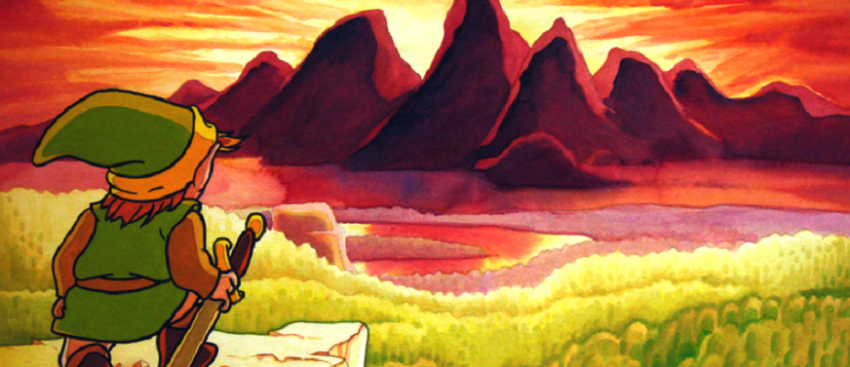Breath of the Wild: Rediscovering the Art of Discovery
Posted on July 15 2016 by Jon Lett
 The Legend of Zelda, the original NES adventure that set so many standards for not only the series, but for adventure titles as a whole, brought about a true sense of discovery for its players. As someone who was not around at its time of release, and started the series with later games, I cannot say I know exactly what it felt like to dive into that exact kind of world for the first time with no concept of what it would be like. That being said, not only was A Link to the Past – a generally similar game – my first adventure title I ever played, but The Legend of Zelda is incredibly easy to read in terms of what made it so revolutionary, so I think I can get a rather good idea. And from what I’ve learned, it is all about the idea of discovery. And now that E3 is over and Nintendo has given us a good, long look at Breath of the Wild, it is clear that they are ready to recapture that glorious feeling of discovering the unknown that was brought about 30 years ago on the NES.
The Legend of Zelda, the original NES adventure that set so many standards for not only the series, but for adventure titles as a whole, brought about a true sense of discovery for its players. As someone who was not around at its time of release, and started the series with later games, I cannot say I know exactly what it felt like to dive into that exact kind of world for the first time with no concept of what it would be like. That being said, not only was A Link to the Past – a generally similar game – my first adventure title I ever played, but The Legend of Zelda is incredibly easy to read in terms of what made it so revolutionary, so I think I can get a rather good idea. And from what I’ve learned, it is all about the idea of discovery. And now that E3 is over and Nintendo has given us a good, long look at Breath of the Wild, it is clear that they are ready to recapture that glorious feeling of discovering the unknown that was brought about 30 years ago on the NES.
Hit the jump to join me in exploring Breath of the Wild‘s throwback style to the series’ original game, and what elements its players might recognize from that age-old classic.
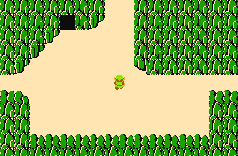 As the player, The Legend of Zelda drops you into a world that is totally unknown to you, with the first thing you see being nothing more than trees, a few paths to take, and an intriguing cave that leads to a friendly Old Man with a helpful gift. After being offered a rather light story at the title screen, landing in this admittedly barren bit of land leaves a lot for you to figure out on your own. There is no sign of “Zelda”, “Gannon” (mistranslated spelling and all), or the “Triforce” – all the things that that light story section mentioned – so again, you are seriously left to your own devices to discover not only the general world around you, but you are also encouraged to think about the history of the land you are travelling through – what once happened to leave it in such a state, where the rest of the people are, and what your actions in this world may lead to once the adventure is over, are all a mystery. A mystery that any fan should be excited to solve.
As the player, The Legend of Zelda drops you into a world that is totally unknown to you, with the first thing you see being nothing more than trees, a few paths to take, and an intriguing cave that leads to a friendly Old Man with a helpful gift. After being offered a rather light story at the title screen, landing in this admittedly barren bit of land leaves a lot for you to figure out on your own. There is no sign of “Zelda”, “Gannon” (mistranslated spelling and all), or the “Triforce” – all the things that that light story section mentioned – so again, you are seriously left to your own devices to discover not only the general world around you, but you are also encouraged to think about the history of the land you are travelling through – what once happened to leave it in such a state, where the rest of the people are, and what your actions in this world may lead to once the adventure is over, are all a mystery. A mystery that any fan should be excited to solve.
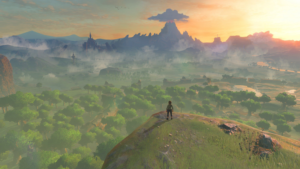 Now, people playing Breath of the Wild are, again, pretty much in the same boat as those playing The Legend of Zelda three decades ago. The new Wii U/NX title seems to have no more of an intro than waking up to an unfamiliar voice, picking up a fancy new tablet, waltzing outside… and that’s it. With no story in sight, one could say you get started with even less that the NES game preceding it, leaving even more answers to seek out and discover. That being said, one can clearly see the similarity between Link’s situation and that of his predecessor. (As in, from a preceding game. Lord knows where on the timeline this takes place.) We arrive outside in the barren and apparently ruined remains of a decades-dead Hyrule, after a catastrophic event 100 years prior that left it in such a state. We are not only left to find a way to survive in this world, but also to discover the mostly scattered people still living in the once prosperous kingdom. Back in the NES days, players had pretty much the exact same tasks. We had a bit of story right off the bat, and the instruction manual gave us some extra details on the current situation, but the actual history of what made this so-called “kingdom” of Hyrule so barren and empty is, again, unknown. Thankfully, rather than having to wait for upwards of 20 years for Hyrule Historia to tell us what happened, Breath of the Wild‘s tale of ruin will be uncovered over the course of the game. The Legend of Zelda, on the series timeline, occurs after the fall of the Hero of Time to the evil king, Ganondorf, in Ocarina of Time. After his defeat, Hyrule slowly but surely declines, being subjected to subsequent attacks from Ganon’s forces until it is left as little more than a barren landscape with the few remaining citizens hiding in caves. As of yet, we do not know much of Breath of the Wild‘s history, but we do know that some iteration of Demise’s recurring hatred attacked again, and left it in ruin many decades prior, much like the NES title. I will not say more than that for the sake of avoiding spoilers. The point is, the only real difference here, plot-wise, is that while it took several generations of decline and attacks for Hyrule to fall apart in The Legend of Zelda, Breath of the Wild‘s dilapidated kingdom seems to have fallen in one fell swoop. Other than that, the situation appears to be all to familiar, right down to the spindly Old Man waiting for you just past the first screen. Almost exactly like players that venturing through the pixelated land of Hyrule 30 years ago, we are going to have to discover all that there is to know about a world we are dropped into with no more than the clothes on our back, and a hair dew that leaves people questioning Link’s gender. …Oh, what? That didn’t happen on NES, too?
Now, people playing Breath of the Wild are, again, pretty much in the same boat as those playing The Legend of Zelda three decades ago. The new Wii U/NX title seems to have no more of an intro than waking up to an unfamiliar voice, picking up a fancy new tablet, waltzing outside… and that’s it. With no story in sight, one could say you get started with even less that the NES game preceding it, leaving even more answers to seek out and discover. That being said, one can clearly see the similarity between Link’s situation and that of his predecessor. (As in, from a preceding game. Lord knows where on the timeline this takes place.) We arrive outside in the barren and apparently ruined remains of a decades-dead Hyrule, after a catastrophic event 100 years prior that left it in such a state. We are not only left to find a way to survive in this world, but also to discover the mostly scattered people still living in the once prosperous kingdom. Back in the NES days, players had pretty much the exact same tasks. We had a bit of story right off the bat, and the instruction manual gave us some extra details on the current situation, but the actual history of what made this so-called “kingdom” of Hyrule so barren and empty is, again, unknown. Thankfully, rather than having to wait for upwards of 20 years for Hyrule Historia to tell us what happened, Breath of the Wild‘s tale of ruin will be uncovered over the course of the game. The Legend of Zelda, on the series timeline, occurs after the fall of the Hero of Time to the evil king, Ganondorf, in Ocarina of Time. After his defeat, Hyrule slowly but surely declines, being subjected to subsequent attacks from Ganon’s forces until it is left as little more than a barren landscape with the few remaining citizens hiding in caves. As of yet, we do not know much of Breath of the Wild‘s history, but we do know that some iteration of Demise’s recurring hatred attacked again, and left it in ruin many decades prior, much like the NES title. I will not say more than that for the sake of avoiding spoilers. The point is, the only real difference here, plot-wise, is that while it took several generations of decline and attacks for Hyrule to fall apart in The Legend of Zelda, Breath of the Wild‘s dilapidated kingdom seems to have fallen in one fell swoop. Other than that, the situation appears to be all to familiar, right down to the spindly Old Man waiting for you just past the first screen. Almost exactly like players that venturing through the pixelated land of Hyrule 30 years ago, we are going to have to discover all that there is to know about a world we are dropped into with no more than the clothes on our back, and a hair dew that leaves people questioning Link’s gender. …Oh, what? That didn’t happen on NES, too?
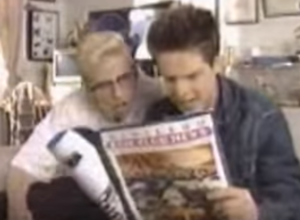 A really neat thing that Zelda has retained throughout it’s 30-year history is players interacting with each other – trading advise and theories, no matter their age, or series experience. Even with only a small fraction of the Breath of the Wild map to look at so far, there have been continuous discoveries and theories spawned from the online community, simply because everyone played/saw the E3 demos in their own way, and found different things in different places in different circumstances. It almost feels as though Nintendo has recaptured the feeling fans got as kids in 1986, playing the original title on NES – getting together with friends on the playground, swapping ideas and secrets they found when they last played. Only now, it’s on a much bigger scale, what with the internet and, appropriately, a MUCH bigger world to explore and talk about. We may be on a singe-player quest to save the world, but no one is going to 100% this game all on their own (if we can 100% it at all). There is a TON to discover, but more importantly, there are a ton of people out there trying to do the same thing, and they can help. So before you go and try consulting a walkthrough when you get stuck on something, try texting a friend, or hitting up some message boards, to share in the beauty of discovery. It’s a great way to meet fellow fans, trust me. You may learn something, and so could they. After all, no one is exploring this world in the same way.
A really neat thing that Zelda has retained throughout it’s 30-year history is players interacting with each other – trading advise and theories, no matter their age, or series experience. Even with only a small fraction of the Breath of the Wild map to look at so far, there have been continuous discoveries and theories spawned from the online community, simply because everyone played/saw the E3 demos in their own way, and found different things in different places in different circumstances. It almost feels as though Nintendo has recaptured the feeling fans got as kids in 1986, playing the original title on NES – getting together with friends on the playground, swapping ideas and secrets they found when they last played. Only now, it’s on a much bigger scale, what with the internet and, appropriately, a MUCH bigger world to explore and talk about. We may be on a singe-player quest to save the world, but no one is going to 100% this game all on their own (if we can 100% it at all). There is a TON to discover, but more importantly, there are a ton of people out there trying to do the same thing, and they can help. So before you go and try consulting a walkthrough when you get stuck on something, try texting a friend, or hitting up some message boards, to share in the beauty of discovery. It’s a great way to meet fellow fans, trust me. You may learn something, and so could they. After all, no one is exploring this world in the same way.
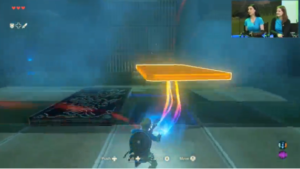 Speaking of my fellow fans, in the past, there have been a couple of discussions among Zelda Dungeons’s writers regarding the age-old style of block and switch puzzles in most Zelda games, and whether those styles are worth reusing in future titles. It is interesting to note that those styles of puzzles are not being thrown away, but rather updated in fascinating new ways! The footage of places like the Magnesis Shrine have presented us with brand new ways of using blocks and moving objects. Others, like the Stasis Shrine, show that we can fiddle with physics, storing momentum in frozen objects before releasing them and watching them fly. Players are being presented with new ways of thinking spatially, but letting them essentially learn it all on their own, like they did in the original. Instead of scrapping the old ways of players using their spacial awareness to manipulate the room and objects around them, they took The Legend of Zelda‘s simple idea of moving blocks and flipping switches, and built on it. Breath of the Wild‘s physics puzzles have you searching for innovative ways to use the new Shiekah Slate abilities to inventively use Link’s surroundings both inside and even outside of Shrines and dungeons, compounding a style of brain-teasing that has been in the series since its inception. A big difference from The Legend of Zelda, though, is that we will be able to discovering interesting uses for items and runes before even needing them for future puzzles. We will have many places out in the world to practice with our new stuff, and to hone our skills before venturing into new dungeons. …That, and finding useless, amazing things like this. Needless to say, discovering the greatness of every individual item will be quite an awesome process.
Speaking of my fellow fans, in the past, there have been a couple of discussions among Zelda Dungeons’s writers regarding the age-old style of block and switch puzzles in most Zelda games, and whether those styles are worth reusing in future titles. It is interesting to note that those styles of puzzles are not being thrown away, but rather updated in fascinating new ways! The footage of places like the Magnesis Shrine have presented us with brand new ways of using blocks and moving objects. Others, like the Stasis Shrine, show that we can fiddle with physics, storing momentum in frozen objects before releasing them and watching them fly. Players are being presented with new ways of thinking spatially, but letting them essentially learn it all on their own, like they did in the original. Instead of scrapping the old ways of players using their spacial awareness to manipulate the room and objects around them, they took The Legend of Zelda‘s simple idea of moving blocks and flipping switches, and built on it. Breath of the Wild‘s physics puzzles have you searching for innovative ways to use the new Shiekah Slate abilities to inventively use Link’s surroundings both inside and even outside of Shrines and dungeons, compounding a style of brain-teasing that has been in the series since its inception. A big difference from The Legend of Zelda, though, is that we will be able to discovering interesting uses for items and runes before even needing them for future puzzles. We will have many places out in the world to practice with our new stuff, and to hone our skills before venturing into new dungeons. …That, and finding useless, amazing things like this. Needless to say, discovering the greatness of every individual item will be quite an awesome process.
Breath of the Wild is set to be a revolutionary leap for the series – the likes of which we have not seen since Ocarina of Time. A lot of people say that it is dropping so many staple conventions of past titles, to make way for “brand new” concepts. But this is not entirely true. Once upon a time, this open-world, discovery-focused gameplay was what made Zelda stand out among its piers – from the very start of the series! I can’t wait to explore this new kingdom – or at least what’s left of it – in a style that dates back to the generation of those I learned about this series from. Seeing things almost through their eyes should be a great way to change how I see the series, and I think the same will be true for many fans, both those relatively new to Zelda, and those whom Zelda has been a part of their lives since 1986.



